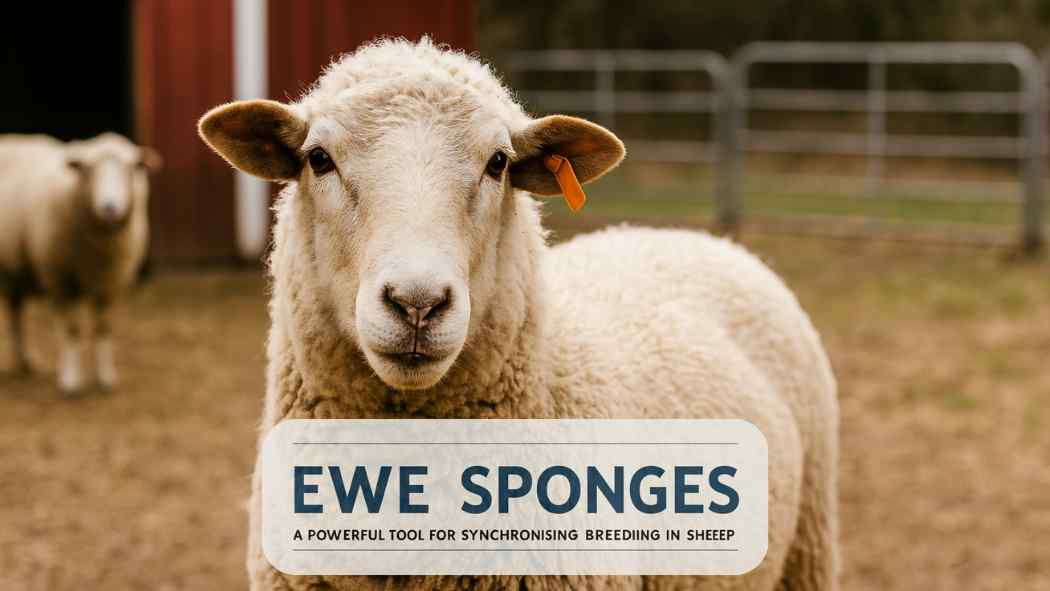Ewe Sponges: A Powerful Tool for Synchronising Breeding in Sheep

The term “ewe sponges” refers to intravaginal devices used in sheep reproduction, designed to synchronise oestrus (heat) and ovulation in female sheep. These small foam devices are impregnated with synthetic hormones and inserted into the ewe for a specific period. When removed, they trigger a controlled hormonal response that brings ewes into heat within a predictable timeframe. This method allows farmers to manage breeding efficiently, improve lambing rates, and maintain healthier, more productive flocks.
What Are Ewe Sponges?
Ewe sponges are intravaginal hormone-releasing devices used to regulate the reproductive cycle of ewes. They are typically made from soft polyurethane foam and contain a progestagen hormone such as flugestone acetate or medroxyprogesterone acetate. When placed inside the ewe’s vagina, these sponges release hormones that simulate the luteal phase of her cycle, preventing oestrus for as long as the sponge remains in place.
Once the sponge is removed, hormone levels rapidly drop, prompting the ewe’s body to enter oestrus (heat). Within 24 to 48 hours, the ewe is ready for mating or artificial insemination. This controlled process allows breeders to plan lambing seasons more accurately, improve conception rates, and manage flock health more effectively.
The Science Behind Ewe Sponges
Ewe reproduction follows a natural hormonal cycle, typically lasting around 17 days during the breeding season. Progesterone plays a key role in this cycle, maintaining pregnancy and regulating oestrus. The ewe sponge works by artificially maintaining progesterone-like hormone levels, effectively pausing the natural cycle.
When the sponge is removed, the ewe’s body perceives a sudden drop in progesterone, which triggers follicle development and ovulation. This hormonal shift ensures that a group of ewes comes into heat at nearly the same time, usually within two days of sponge removal.
This synchronisation is vital for commercial sheep farms where efficiency and timing are crucial. It allows farmers to manage breeding and lambing on a larger scale without unpredictability.
Advantages of Using Ewe Sponges
There are numerous reasons why farmers and breeders use ewe sponges in their reproductive programmes.
1. Synchronised Breeding
The primary purpose of ewe sponges is to synchronise oestrus, ensuring that a group of ewes becomes fertile simultaneously. This makes it easier to coordinate mating or artificial insemination, reducing labour and improving productivity.
2. Controlled Lambing Seasons
Synchronised oestrus leads to concentrated lambing periods. Farmers can plan feeding schedules, veterinary care, and labour more effectively, leading to improved lamb survival rates and healthier flocks.
3. Enhanced Genetic Management
Using ewe sponges allows breeders to plan artificial insemination from high-quality rams, improving the genetic potential of future lambs. This is particularly valuable for pedigree and performance-focused breeders.
4. Out-of-Season Breeding
In some regions, certain breeds do not naturally breed out of season. Ewe sponges help induce oestrus even during non-breeding months, providing flexibility and enabling year-round production.
5. Improved Lamb Uniformity
Synchronised breeding ensures that lambs are born around the same time, resulting in uniform growth and consistent weight gain, which simplifies marketing and management.
Step-by-Step Use of Ewe Sponges
To achieve the best results, it is important to follow proper handling and timing procedures when using ewe sponges.
1. Preparation
Before starting, ensure all ewes are in good health, free from infections, and in suitable body condition. Nutrition should be adequate, and all animals should be managed hygienically.
2. Insertion
Using a clean applicator, the sponge is gently inserted into the ewe’s vagina. The attached string is left hanging slightly outside to make removal easier. The sponge should remain in place for about 12 to 14 days, depending on the manufacturer’s instructions.
3. Removal and Hormone Injection
After the designated time, the sponge is removed by pulling the attached string. At this stage, a small injection of equine chorionic gonadotropin (eCG) or a similar hormone is often administered to stimulate ovulation. Within 24 to 48 hours, most ewes will come into heat.
4. Mating or Artificial Insemination
Once the ewes show signs of oestrus, they should either be introduced to rams or inseminated. For natural mating, a ratio of one ram to ten ewes is typically recommended to ensure successful breeding.
5. Monitoring and Record-Keeping
Farmers should record the date of sponge insertion, removal, hormone injection, and mating. After lambing, outcomes should be noted to assess the success of the synchronisation programme.
Factors Affecting Success
The success of ewe sponge programmes depends on several key factors:
-
Animal Condition – Healthy ewes with proper nutrition respond best. Underfed or stressed animals may not ovulate successfully.
-
Season and Breed – Some breeds respond better than others, and results can vary depending on whether it is the natural breeding season.
-
Hygiene – Poor hygiene during insertion or removal can lead to infections such as vaginitis, which may reduce conception rates.
-
Timing – Accurate timing of sponge removal, hormone injection, and mating is critical. Even small delays can reduce synchronisation efficiency.
-
Ram Fertility – Rams must be healthy, active, and capable of serving multiple ewes within a short period.
Potential Risks and Limitations
Despite their many benefits, ewe sponges are not without limitations.
-
Vaginal Irritation or Infection: If sponges are left for too long or inserted unhygienically, ewes can develop infections or discharge.
-
Sponge Loss: Some ewes may expel the sponge prematurely, which affects synchronisation.
-
Labour and Cost: The procedure requires careful handling, timing, and sometimes hormone injections, adding to management costs.
-
Over-Concentrated Lambing: Having too many lambs born in a short time can strain resources, especially if labour or shelter is limited.
-
Variable Response: Not all ewes respond equally; some may fail to come into heat, particularly if they are underweight or outside the breeding season.
Economic and Practical Benefits
When properly implemented, the cost of using ewe sponges is offset by the improved efficiency of breeding and lambing operations. Synchronised lambing allows farmers to better manage feeding schedules, market timing, and veterinary supervision. Lambs born together can be sold as uniform batches, often fetching higher market prices.
For farmers in developing regions such as Pakistan, ewe sponges can help manage climate and feed challenges by shifting lambing to favourable seasons. However, availability, veterinary guidance, and product regulation should be verified before use.
Best Practices for Farmers
To make the most of ewe sponge programmes, consider these best practices:
-
Always consult a qualified veterinarian before beginning.
-
Handle the devices with gloves and maintain sterile conditions.
-
Use clean, well-designed applicators and disinfect them between uses.
-
Never reuse a sponge; each one is designed for single use only.
-
Monitor ewes closely after sponge removal for signs of heat.
-
Introduce rams promptly once ewes show behavioural changes indicating oestrus.
-
Record all procedures carefully for future planning and improvement.
The Role of Nutrition and Management
Nutrition plays a major role in the success of any breeding programme. Ewes must have access to balanced feed rich in energy, protein, and minerals. Poor nutrition can lead to low conception rates, weak lambs, or delayed oestrus. Similarly, stress factors such as extreme weather, transportation, or overcrowding can negatively affect hormonal balance and fertility.
Farmers should ensure adequate shelter, clean water, and routine health checks for both ewes and rams. Vaccinations, parasite control, and hoof care should be up to date before beginning synchronisation.
Sustainability and Future Outlook
As technology advances, ewe sponges are being improved for comfort, hygiene, and effectiveness. Research continues to develop biodegradable materials and optimised hormone formulations. In addition, precision livestock tools are emerging, allowing farmers to track oestrus cycles and predict fertility windows more accurately.
For sustainable agriculture, ewe sponge programmes must be integrated with responsible breeding, good welfare standards, and minimal environmental impact. The goal is to combine reproductive efficiency with animal well-being and long-term farm profitability.
Conclusion
Ewe sponges represent one of the most effective and reliable tools for synchronising reproduction in sheep. They allow farmers to control breeding schedules, improve genetic quality, and optimise flock management. When used with proper hygiene, timing, and nutrition, ewe sponges can significantly increase lambing success and overall productivity.
Although the process requires investment and careful planning, the results often justify the effort, especially for professional sheep breeders. By understanding the science, following protocols, and maintaining high standards of animal welfare, farmers can harness the full potential of ewe sponges to build stronger, healthier, and more profitable flocks.



